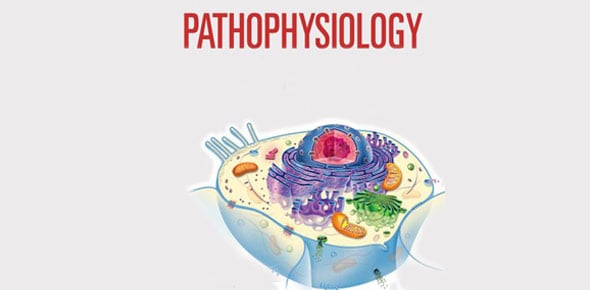Pathophysiology: Liver

- 1.
What is the function unit of the liver?
- A.
Reticuloendothelial cell
- B.
Hepatocyte
- C.
Kupffer cell
- D.
Lipocyte
Correct Answer
B. Hepatocyte -
- 2.
Which is NOT a function of the liver?
- A.
Carbohydrate metabolism
- B.
Breakdown of plasma proteins
- C.
Storage of vitamins
- D.
Absorption of lipids
Correct Answer
D. Absorption of lipidsExplanation
The liver is involved in glycolysis. It secretes bile for lipid emulsification in the duodenum.Rate this question:
-
- 3.
Which is the lesser, posterior lobe of the liver?
- A.
Right
- B.
Left
- C.
Caudate
- D.
Quadrate
Correct Answer
C. Caudate -
- 4.
The liver receives ____ of the cardiac output.
- A.
10%
- B.
25%
- C.
40%
- D.
70%
Correct Answer
B. 25% -
- 5.
When does detoxification in the liver occur?
- A.
Before digestion
- B.
After digestion
- C.
Before secretion
Correct Answer
B. After digestionExplanation
Detoxification occurs via the portal vein system which collects blood from the GI after food digestions has begun.Rate this question:
-
- 6.
The liver is regenerable via hyperplasia of hepatocytes.
- A.
True
- B.
False
Correct Answer
A. True -
- 7.
What enzyme permits the relase of free glucose into the blood stream?
- A.
Sucrose-6-phosphatase
- B.
Glucose-4-phosphatase
- C.
Galactose-4-phosphatase
- D.
Glucose-6-phosphatase
Correct Answer
D. Glucose-6-phosphatase -
- 8.
The liver can provide major clues about acute insult of many systemic changes from infection or inflammation. What is a major marker of bacterial infection?
- A.
Plasma alapa-globin
- B.
C-reactive protein
- C.
Ceruloplasmin
- D.
Albumin
Correct Answer
B. C-reactive protein -
- 9.
A deficiency of ceruloplasmin is diagnostic finding of a condition of toxic accumulation of copper in the brain, liver, skin, and joints called?
- A.
Jaundice
- B.
Hemochromatosis
- C.
Wilson disease
- D.
Gilbert syndrome
Correct Answer
C. Wilson disease -
- 10.
How are plasma proteins degraded?
- A.
Lysosomes
- B.
Proteasomes
- C.
Ubiquitin
- D.
Alpha-fetoprotein
Correct Answer
A. LysosomesExplanation
After endocytosis of plasma proteins, they are hydrolyzed by acid protesases within intracellular organelles called lysosomes. Intracellular proteins are degraded within proteasomes marked by ubiquitin.Rate this question:
-
- 11.
Ammonia is particularly toxic to what body system?
- A.
Muscle
- B.
Respiratory
- C.
Cardiovascular
- D.
CNS
Correct Answer
D. CNS -
- 12.
Heme is a constituent of
- A.
Myoglobin
- B.
Hemoglobin
- C.
Cytochromes
- D.
All the above
Correct Answer
D. All the above -
- 13.
What form of bilirubin is fat soluble?
- A.
Unconjugated bilirubin
- B.
Conjugated bilirubin
- C.
Free bilirubin
Correct Answer
A. Unconjugated bilirubinExplanation
Conjugated and free bililrubin are synonymous. Biliverdin is oxidized bilirubin that is water soluble.Rate this question:
-
- 14.
What type of jaundice is cholelithiasis classified?
- A.
Prehepatic
- B.
Intrahepatic
- C.
Posthepatic
Correct Answer
C. Posthepatic -
- 15.
What factor is responsible for the majority of drug metabolism?
- A.
K
- B.
N
- C.
Alpha1-trypsin
- D.
Cytochrom P-450
Correct Answer
D. Cytochrom P-450 -
Quiz Review Timeline +
Our quizzes are rigorously reviewed, monitored and continuously updated by our expert board to maintain accuracy, relevance, and timeliness.
-
Current Version
-
Mar 04, 2013Quiz Edited by
ProProfs Editorial Team -
Nov 11, 2012Quiz Created by
Hollylisa2080
- Computed Tomography Quizzes
- EEG Quizzes
- First Aid Quizzes
- GCP Quizzes
- Healing Quizzes
- Mammography Quizzes
- Medical Coding Quizzes
- Medical Science Quizzes
- Medical Term Quizzes
- Medical Terminology Quizzes
- Medical Training Quizzes
- Medical Vocabulary Quizzes
- MRI Quizzes
- Nuclear Medicine Quizzes
- Obstetrics And Gynecology Quizzes
- Phlebotomy Quizzes
- Pulmonary Quizzes
- Radiography Quizzes
- Radiology Quizzes
- Syndrome Quizzes
- Ultrasound Quizzes
- Vital Signs Quizzes
- Xray Quizzes
 Back to top
Back to top


